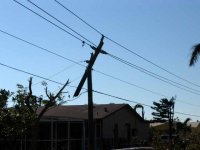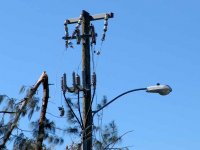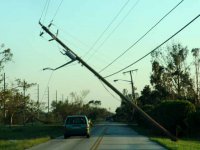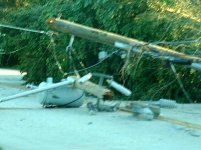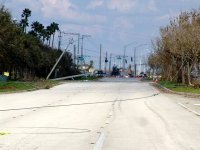> winter of 1997 and the footage of power pylons buckling due to ice storms

> was a real eye opener for someone from a damp little island.
Or anybody who forgot the Great Blizzard of 1888, when parts of NYC were completely entangled in fallen telephone wires for many days. (No multi-pair cables yet- two wires per phone, hundreds of wires along the streets.)

In the aftermath of that mess, Bell System made great strides in underground cable, and NYC cleaned-up its overhead wire-mess long before many other cities did.
> power pylons buckling
Funny thing is: up-state Maine, we have hardly any steel pylons. Main power lines run on WOOD poles. And we do have ice and wind! As far as I know, these mainline tree-poles have not been a major failure point. We do have pole failures along lesser lines where engineering may be a bit more casual, and Jeeps hit them.

> was a real eye opener for someone from a damp little island.
Or anybody who forgot the Great Blizzard of 1888, when parts of NYC were completely entangled in fallen telephone wires for many days. (No multi-pair cables yet- two wires per phone, hundreds of wires along the streets.)

In the aftermath of that mess, Bell System made great strides in underground cable, and NYC cleaned-up its overhead wire-mess long before many other cities did.
> power pylons buckling
Funny thing is: up-state Maine, we have hardly any steel pylons. Main power lines run on WOOD poles. And we do have ice and wind! As far as I know, these mainline tree-poles have not been a major failure point. We do have pole failures along lesser lines where engineering may be a bit more casual, and Jeeps hit them.
Here in California its starts at around $.11/KWh and goes through tiers quickly to $.35/KWh. This is all thanks to Enron. My electric bills are in $200/300 range and its nearly impossible to get it much lower.
In Ontario we have three rates.
Off peak - 8.7 cents (for those that do laundry at 2:00 AM)
midpeak - 13.2 cents
peak - 18.0 cents
However they also stick us with distribution and debt repayment charges giving Ontario the highest hydro rates in North America. Some people are having to make the choice between food and heat because of the rates.
I'll stop there, I'm getting angry.
There's a lot of anger.
Recently Ontario is investing heavily in wind and solar, offering 20 year contracts to buy energy from "green" providers at up to $0.80 /kwh, which is obviously a lot more than they get paid for it. (See Ontario FIT and MicroFit programs if you are interested.) The new contract rates are down somewhat now (although the old ones will continue to pay $0.80 /kwh for the full 20 years) and new contracts will end completely soon, with only net metering being offered.
My father often jokes about the "delivery" charge on the bill. I must have been sleeping when the truck came, he says. And the debt retirement charge is a mess of things that should have been paid for a long time ago.
My father maintains a property with electric service which is unused for about 8 months of the year. I asked him what the bills are like in months when no power is used. He said the bills are always for 1 kwh even if no power is used, and that monthly 1 kwh bill is $82 due to delivery and debt retirement charges.
There's a current case in the courts about a man with a remote vacation property. A storm knocked out his power line so his property had no service. The power company was not able to fix it for several months due to the remote location. They billed him anyway, saying if he didn't want to be billed he should have cancelled his service. So apparently they couldn't get to it to fix it but it wouldn't have been any problem to turn it off (as if the broken power wires didn't already do that). There's also an ongoing class action lawsuit over rates but I'm not sure of the details or who is actually being sued - the provincial government or the privatized Hydro One company.
There's a lot of anger and unrest here in Ontario as Toronto wants "green" energy but they don't want it in their backyard. So here in the rural areas wind farms are sprouting up everywhere despite the local opposition. These contracts are going to international companies too, it isn't the power company or local business benefiting here.
To continue talking about this would require getting way too political but it's true, lots of people are having to choose food or power around here, about 1/4 of the posts I see on facebook these days are about power prices and Kathleen Wynne ...
BTW, I'm guessing most of the power here comes from Niagara Falls, despite the huge local influx of the "green" power generation.
Last edited:
In an ironic twist of fate.....our power is out. It's been out for two hours and the only estimate we get from Appalachian Power is "by morning." I have a UPS connected to my cable box to keep the internet and phone alive until their service goes down, typically about 4 hours after the power goes off.
It's a mesh networked grid of all power meters using technology similar to WiFi, but at a lower frequency for longer range. I am in the middle of nowhere West Virginia. There is no normal cell phone coverage here. A neighbor has a microcell connected by internet to provide coverage for a 200 foot radius.
My meter links to the neighbors meter and all other meters it can find. The next meter does the same. Each meter is a node in the mesh. They have the ability to build a network of similar nodes, and find an RF route to the master node which is hardwired to the data collection point. There are usually multiple masters. The mesh is self healing. If one node or several go down the remaining nodes will build a new mesh and find a new route to the master.
Unreachable nodes are reported automatically. Tonight I got an email sent to my cell phone stating that about 3500 customers were down about 10 minutes after the power went off. About half an hour later a second email reported an exact number over 4000. Roughly 1/4 the population of the county.
It's wireless (or RF over wires) somehow.
It's a mesh networked grid of all power meters using technology similar to WiFi, but at a lower frequency for longer range. I am in the middle of nowhere West Virginia. There is no normal cell phone coverage here. A neighbor has a microcell connected by internet to provide coverage for a 200 foot radius.
My meter links to the neighbors meter and all other meters it can find. The next meter does the same. Each meter is a node in the mesh. They have the ability to build a network of similar nodes, and find an RF route to the master node which is hardwired to the data collection point. There are usually multiple masters. The mesh is self healing. If one node or several go down the remaining nodes will build a new mesh and find a new route to the master.
Unreachable nodes are reported automatically. Tonight I got an email sent to my cell phone stating that about 3500 customers were down about 10 minutes after the power went off. About half an hour later a second email reported an exact number over 4000. Roughly 1/4 the population of the county.
There's a range of technologies in use. 434/868MHz mesh, cellular, long range point to point, you name it and someone somewhere has tried it!
> My father often jokes about the "delivery" charge on the bill. I must have been sleeping when the truck came, he says.
Well, would he rather drive to the dam generator and pick up a bucket of electrons?
"Delivery" is a very significant cost. I'm 10 miles from a dam which could supply power. (In fact it only peaks; base power comes 20 miles further.) I was looking at my pathetic 500-foot line to the street, and idly started estimating the cost to bring my amount of power the whole 10 miles. 100 times the wire is $200,000. And same-size, the voltage drop looks like 2,000%! The math is wrong, but the results sure suck. I would want wire 100 times fatter (2-inch instead of 0.2") to get the same voltage drop. Now approaching $20,000,000! Plus right of way, and poles...
OK, "AC". Step-up 100X. Line current only 1A, but it still needs 0.2" wire to keep the same voltage drop. Back to $200,000, plus a couple grand for transformers.
Power lines last a long time. Figured on 20 years the $200,000 is $10,000/year, $833/month, or over 10 times what I pay now for "delivery". If long-term financed by a corporation we'd amortize over 50 years, but the investors need that dividend check every quarter, so it won't be a whole lot less.
Obviously public utilities leverage large economy of scale and diversity of load. I could pull 100 Amps, but my average load is under 10A, and so with all my neighbors. While my area is served by roughly the 100X voltage (probably 13KV), the longer lines from the base generators run 60KV. And wire price does drop some in bulk.
"Delivery" may sound funny, but getting-it-to-you is really a very large cost, and what else you gonna call it? "Wires" is too technical for most customers, and neglects costs of substation gear and network oversight.
Well, would he rather drive to the dam generator and pick up a bucket of electrons?
"Delivery" is a very significant cost. I'm 10 miles from a dam which could supply power. (In fact it only peaks; base power comes 20 miles further.) I was looking at my pathetic 500-foot line to the street, and idly started estimating the cost to bring my amount of power the whole 10 miles. 100 times the wire is $200,000. And same-size, the voltage drop looks like 2,000%! The math is wrong, but the results sure suck. I would want wire 100 times fatter (2-inch instead of 0.2") to get the same voltage drop. Now approaching $20,000,000! Plus right of way, and poles...
OK, "AC". Step-up 100X. Line current only 1A, but it still needs 0.2" wire to keep the same voltage drop. Back to $200,000, plus a couple grand for transformers.
Power lines last a long time. Figured on 20 years the $200,000 is $10,000/year, $833/month, or over 10 times what I pay now for "delivery". If long-term financed by a corporation we'd amortize over 50 years, but the investors need that dividend check every quarter, so it won't be a whole lot less.
Obviously public utilities leverage large economy of scale and diversity of load. I could pull 100 Amps, but my average load is under 10A, and so with all my neighbors. While my area is served by roughly the 100X voltage (probably 13KV), the longer lines from the base generators run 60KV. And wire price does drop some in bulk.
"Delivery" may sound funny, but getting-it-to-you is really a very large cost, and what else you gonna call it? "Wires" is too technical for most customers, and neglects costs of substation gear and network oversight.
Yes, I remember. I did some work for the EDF back in the 1980s.The Électricité de France (EDF) is owned for 85% by the state.
I suppose, but in any French city I've lived or worked in, it was predominantly gas. Some electric, of course, just like in the UK. Accumulation heaters and such. Out on the farm it was wood and electric. Perhaps rural England has more gas heat than France. Demand was 60% higher in France when I looked at it today. That's huge.Regarding their own power usage: I think/guess France does not use natural gas as much as the other countries so heating is done mostly electrically.
> My father often jokes about the "delivery" charge on the bill. I must have been sleeping when the truck came, he says.
Well, would he rather drive to the dam generator and pick up a bucket of electrons?
No, he would prefer the old flat rate charge of around $38 (+ kwh usage) before the system started going crazy and dividing up the extra charges into different categories and charging more than twice as much for the same service.
No matter how the usage and surcharges are divided our rates are very high now and this is a recent change. Where else in the developed world do you see an $82 monthly bill for no usage?
I fully realize that there is a whole grid that needs to be maintained and updated. The new higher rates have nothing to do with that, the system was sustainable (maybe stretched a bit thin but sustainable) under the old rate system. The new higher rates are due to the cost of buying electricity at $0.80 /kwh, selling off portions of the publicly funded utility to private businesses which obviously always increases end user rates, and lining some big name high profile pockets. No matter how you slice it, if they pay $0.80 /kwh for power produced under private contracts the end user is going to have to pay at least $0.80 /kwh for that same power - call it usage, delivery, debt retirement, tax, subsidy, whatever. And that's just the cost of the power itself, the end user still has to pay for the grid maintenance, power company capital (vehicles, tools, etc) and employee salaries (and benefits and pensions), and everything else on top of that. When you start handing out millions of dollars worth of long term contracts to suppliers at $0.80 /kwh it's pretty clear to see how the total cost of the service for the end user can spiral out of control very quickly.
While my father makes jokes the rates are getting high enough that I'm seriously considering going off grid. Even a few years ago this is something that seemed crazy, now it seems very sane and a great return on investment. When the rates are high enough that ANYONE connected to the grid would seriously consider going off grid, things are very wrong. With the economies of scale and Niagara Falls just a couple hours down the road the power company should be able to provide power cheap enough that going off grid would be a bad financial move for any end user and that's the way it was just a few short years ago. Not anymore.
Last edited:
going off grid is huge investment IF you get it right the 1st time & most don't.When the rates are high enough that ANYONE connected to the grid would seriously consider going off grid, things are very wrong.
just batteries over a 10 year life max will run over $50 /mo yes? but they will probably get wrecked if you aren't there to baby them.
The solar folks getting a free ride from the grid wont last either, believe that.. It doesn't matter what their contract says. No one will hold that note.
Last edited:
The Solar payback is already winding down in a lot of places. Too bad, it was a good way to get things rolling.
going off grid is huge investment IF you get it right the 1st time & most don't.
just batteries over a 10 year life max will run over $50 /mo yes? but they will probably get wrecked if you aren't there to baby them.
A modest 4kw system is maybe $5000, definitely less than 10 (I already have a generator and unlimited amounts of smoke to power it via gasification). If I can get the gasification system working properly the whole thing should pay for itself in about 2 years.
The solar folks getting a free ride from the grid wont last either, believe that.. It doesn't matter what their contract says. No one will hold that note.
Not sure what free ride you are talking about, but in Ontario the Fit and Microfit contracts are ironclad 20 year government contracts guaranteeing $0.80 /kwh. I think the new contracts are for around $0.40 /kwh, and they may run out this year as they reach the mandated amount of contracted power. After that the Fit/MicroFit literature specifically says the government plans to transition to net metering for anyone interested. I'm not interested, I want to go completely off grid because even if I net meter a 0 kwh monthly usage I'm still going to get a monthly $82 bill for delivery and debt retirement. Probably the bill will be even larger for the "privilege" of net metering.
As far as battery lifespan, they should last a very long time if you keep them maintained and never discharge them to below 80 percent which is very possible if the battery bank is large enough. Large deep cycle batteries aren't that expensive anyway.
Interesting.
I´m mumbling about getting a solar/wind backup system.
Not as a main system by any means, standard home power consumption is HUGE by any standards, and going over it with a loupe will certainly show that lots of it is plain waste or nonsense (as in heating twice as much water as will actually be used in a shower, cooking something and placing it still warm in the fridge and so on) but as a essentials backup system: light, computer/phone/bell-alarm and little more.
Forget cooking/heating but at least to avoid fumbling in the dark, bored to hell, and maybe including *a little* cooling, such as a small styrofoam cooler with a low power peltier system, all 12V powered, to at least keep milk and meat from spoiling.
I bought a powerful Industrial/Commercial rated Briggs and Stratton gasoline generator but it´s the most expensive electricity I ever used, a 1 gallon gas tank lasts some 4 or 5 hours tops.
Does not seem that much until you do the Math 24/7 ; a Month on home made electricity can make a BIG hole.
Yes, it runs all of my home plus the shop, with carpentry machinery (I make my own cabinets) , an air compressor, lathe, fridges, chest freezer, can even run my magnetizer if I stop everything else, but is justified only on emergencies, hence the wish for a light backup "green" system.
I´m mumbling about getting a solar/wind backup system.
Not as a main system by any means, standard home power consumption is HUGE by any standards, and going over it with a loupe will certainly show that lots of it is plain waste or nonsense (as in heating twice as much water as will actually be used in a shower, cooking something and placing it still warm in the fridge and so on) but as a essentials backup system: light, computer/phone/bell-alarm and little more.
Forget cooking/heating but at least to avoid fumbling in the dark, bored to hell, and maybe including *a little* cooling, such as a small styrofoam cooler with a low power peltier system, all 12V powered, to at least keep milk and meat from spoiling.
I bought a powerful Industrial/Commercial rated Briggs and Stratton gasoline generator but it´s the most expensive electricity I ever used, a 1 gallon gas tank lasts some 4 or 5 hours tops.
Does not seem that much until you do the Math 24/7 ; a Month on home made electricity can make a BIG hole.
Yes, it runs all of my home plus the shop, with carpentry machinery (I make my own cabinets) , an air compressor, lathe, fridges, chest freezer, can even run my magnetizer if I stop everything else, but is justified only on emergencies, hence the wish for a light backup "green" system.
Not sure what free ride you are talking about,As far as battery lifespan, they should last a very long time if you keep them maintained and never discharge them to below 80 percent which is very possible if the battery bank is large enough. Large deep cycle batteries aren't that expensive anyway.
deep cycle batteries can last a long time. ask the engineers what they are rated for. I reckon 10 years is a good average lifespan for a lean/ mean system and very well maintained. I think further north you go the tougher it is on the batteries solar design. Also a 3-5 day cloud cover isn't unusual so you will need a automatic gen set added on $$$. The key to long bat. life is an 'equalization' schedule built in and stick to it. Yer lucky the best storage batts are made right there in Canada.http://rollsbattery.com/wp-content/uploads/warranty/Warranty.pdf
my comment about Solar on the grid is mainly for my area. We don't have those delivery line items. That is supposed to be amortized by everyone consuming from it. If the solar guys are net zero consumption or better, well then ...its a free ride.
Last edited:
yeah forget central heating / cooking on solar electrics.Interesting.
I´m mumbling about getting a solar/wind backup system.
Not as a main system by any means, standard home power consumption is HUGE by any standards, .
Most folks that have dual wind and solar have ditched the wind set ups as time went on.
Target the biggest electric consumption and get green , 1st get the most efficient DC food refrigeration and freezer set ups. Probably chest types with German DC compressors units. Ask some of the marine installers for advice.
I know you can buy specialized DC 12/24 chest refrigerator ready made but theyll cost esp. shipping, DIY or custom is always an option esp. on boats.
Last edited:
yeah forget central heating / cooking on solar electrics......Target the biggest electric consumption
By far the biggest energy consumer here is home heating in the winter. Ten to fifteen years ago I met a guy here that lived way out in the country on a farm. His electrical service was rather unreliable and outages could be days long. He had devised a rather unusual system for backup / high demand power.
He had an old 4 cylinder automobile engine, modified to run on several fuels, but mostly propane or a blend of gasoline and home brewed alcohol. The engine spun a collection of automotive alternators that generated electricity either for direct consumption, lights, space heaters and other items that would operate on 120 VDC. One or two alternators fed a collection of batteries. Some appeared to be car batteries, and some were marine trolling motor batteries (deep cycle).
The engine coolant was piped inside the house, and run through 3 or 4 ordinary automobile radiators with what looked like fans from old PC's on them. This effectively heated several rooms.
There was some sort of heat recovery system on the engine exhaust, but it was all enclosed inside a wooden box, and the output was liquid, again piped through car radiators in the basement.
There were a few solar panels connected to batteries for some power, to provide emergency power, but the whole system looked like it came from a roadside illuminated sign.
The auto engine did not run at a very high RPM, I'm guessing 2000 RPM by the sound, and it was rather quiet. The alternators made more noise than the engine.
I learned back in the 70's that a GM car alternator can generate 120 VDC. Run 12 volts directly to the field winding and spin it fast enough to get 120 VDC. The diodes in an alternator pirated from a 70 Pontiac will fail at around 150 volts. The resulting short will attempt to stall the alternator resulting in a lot of smoke from the belt driving it.
I mentioned previously that we had no power for 22 days due to hurricane Wilma in 2005. This is why. These are all pictures I took during the first few days after the storm. There were some areas so messed up that I didn't venture into them on my bicycle.
The square concrete distribution (14.4 KV) poles that had a street light ALL failed, or the light was torn off. It swayed back and forth in the wind until something broke.
The wood poles in the residential areas either broke in half, or lost all their wires.
Sometimes the transformers just fell off, other times they brought the pole, or part of the pole with it.
Attachments
I like that story! That's a guy who really knows how to squeeze very lats bit of heat energy out of the engine. 
I lived in a house that had a rather nice 12KW generator fired by natural gas. It ran off the same gas line as the house. Automatic switcher and all. It also ran for 30 minutes each week to exercise. V-Twin Briggs and Stratton engine. Not very quiet, even insde the insulated housing. But it worked great.

I lived in a house that had a rather nice 12KW generator fired by natural gas. It ran off the same gas line as the house. Automatic switcher and all. It also ran for 30 minutes each week to exercise. V-Twin Briggs and Stratton engine. Not very quiet, even insde the insulated housing. But it worked great.
CHP (combined heat and Power) were the next big thing in microgeneration about 10 years ago* then got sidelined by renewables until recently. Makes a lot of sense as if you look at a piston engine roughly 33% of the energy from fuel goes into the shaft, 33% as heat into the block and the rest out the exhaust. A 1 litre 4 pot running off natural gas can power and heat about 10 std uk hovels. very efficient, but grants are limited, so not done.
Big cathedral diesels on container ships can extract megawatts out the waste exhaust.
*concept wasn't new then, but moneys were flowing into it.
Big cathedral diesels on container ships can extract megawatts out the waste exhaust.
*concept wasn't new then, but moneys were flowing into it.
Took me a minute to parse the meaning of that phraseA 1 litre 4 pot running off natural gas ...
- Status
- Not open for further replies.
- Home
- Member Areas
- The Lounge
- KWh vs $

